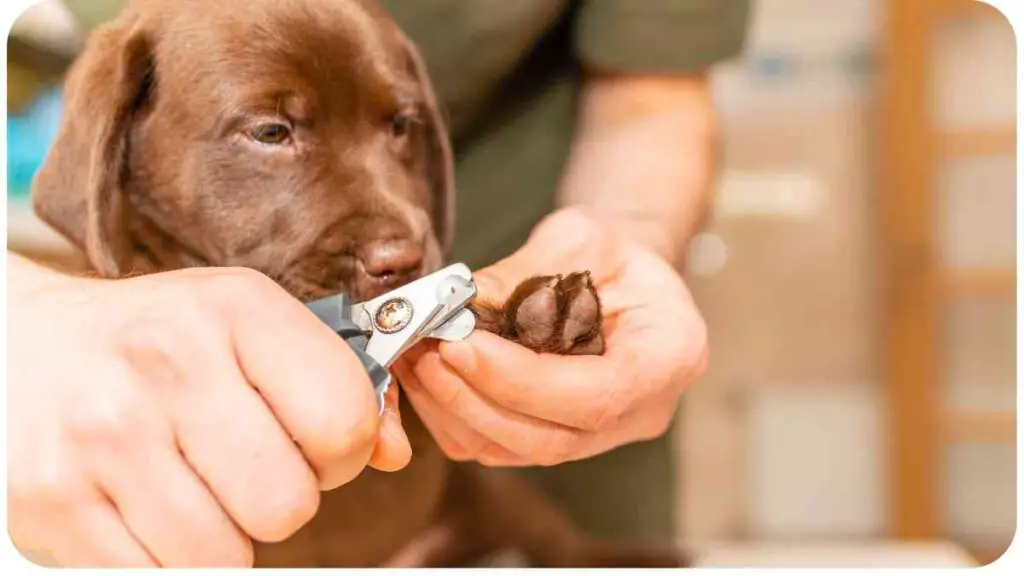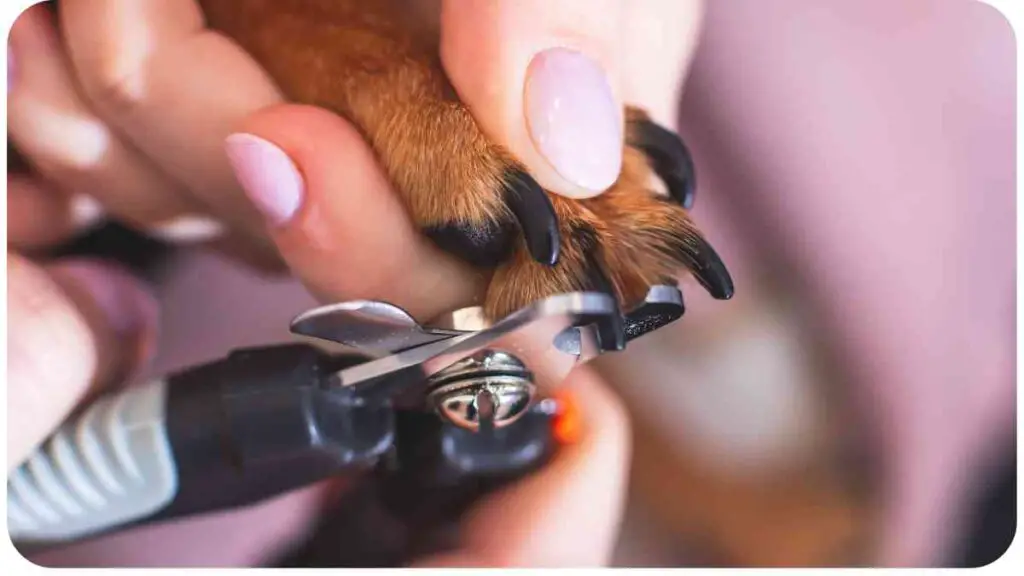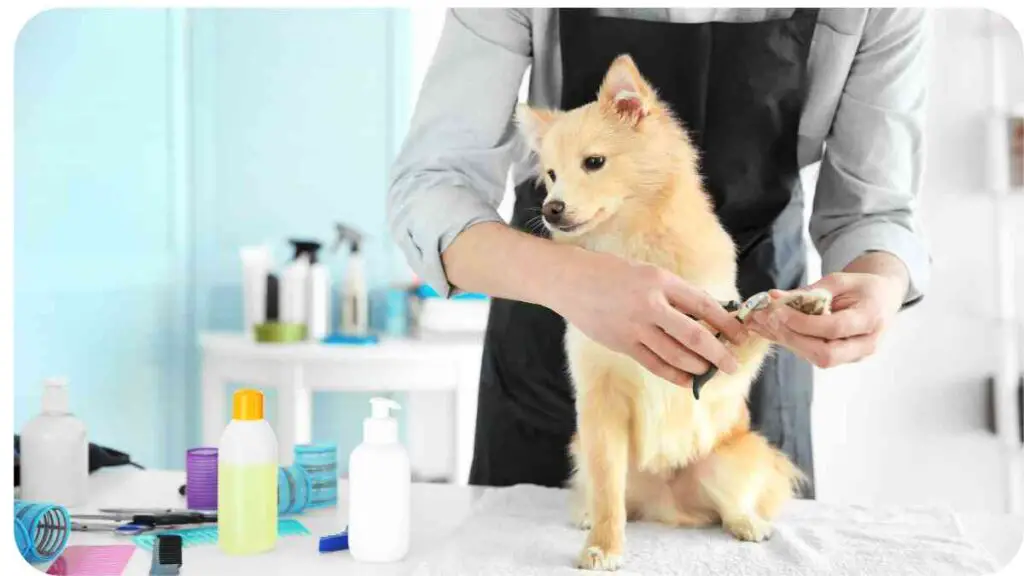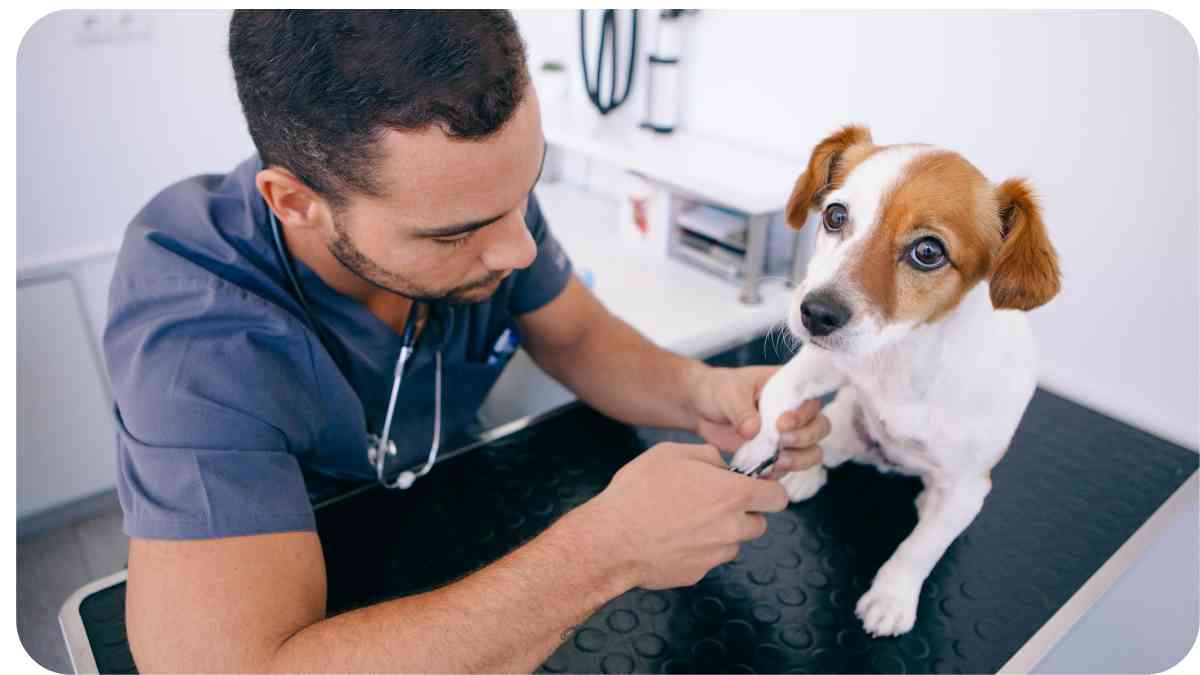Have you ever noticed your dog limping or licking its paw incessantly? It could be a sign of a broken nail. As a pet owner, it’s essential to understand how long it might take for a broken dog nail to fall off and what you can do to help your furry friend.
Broken nails are a common issue and can be quite painful for dogs. In this article, we’ll dive into the causes, symptoms, treatment, and healing process for broken dog nails.
| Key Points |
|---|
| Broken dog nails are common and can be painful. |
| Immediate first aid is crucial to prevent infection. |
| The healing time varies based on severity and health of the dog. |
| Regular nail trimming can prevent broken nails. |
| Seek veterinary help for excessive bleeding or signs of infection. |
| Use protective bandages and keep the area clean to aid healing. |
| Overgrown nails are more prone to breaking. |
| Nail grinders can provide a smooth finish and prevent snagging. |
| Myths about broken nails can lead to improper care. |
| Consult experts for the best practices in nail care for your dog |
Causes of Broken Dog Nails

Dogs can break their nails in various ways. Common activities such as playing, running, or even walking on rough surfaces can lead to a broken nail. Overgrown nails are particularly susceptible to breaking because they can catch on objects more easily. Additionally, certain health conditions can weaken a dog’s nails, making them more prone to breakage.
When dealing with a broken dog nail, it’s crucial to understand proper treatment. For guidance on handling infections that may arise, you can check out this article on how to treat a yeast infection on your dog’s paw.
Common Activities Leading to Broken Nails
- Running on rough terrain
- Catching nails in carpets or other materials
- Excessive scratching
- Overgrown nails getting snagged
Symptoms of a Broken Dog Nail
Identifying a broken dog nail is crucial for timely intervention. Some common symptoms include limping, licking the affected paw, bleeding, and visible damage to the nail. Your dog may also show signs of discomfort or pain, such as whimpering or avoiding putting weight on the affected paw.
How to Identify a Broken Nail
- Limping or favoring one paw
- Licking or chewing the affected area
- Visible damage or splitting of the nail
- Bleeding from the nail bed
- Signs of pain or discomfort
First Aid for a Broken Dog Nail
When you notice your dog has a broken nail, it’s essential to act quickly to minimize pain and prevent infection. First, calm your dog and restrain them gently to avoid further injury. Clean the affected area with a mild antiseptic and apply pressure to stop any bleeding. If the nail is hanging or broken but still attached, it might be best to trim the loose part carefully. Bandage the paw to keep it clean and protected.
Keeping your dog’s nails trimmed is important for their health. To find the best tools for maintaining your dog’s nails, explore this comprehensive review of best claw clippers for dogs.
Immediate Steps to Take
- Calm and restrain your dog.
- Clean the area with antiseptic.
- Apply pressure to stop bleeding.
- Trim any loose parts of the nail.
- Bandage the paw to prevent infection.
Table: First Aid Kit Essentials
| Item | Purpose |
|---|---|
| Antiseptic solution | Clean the wound |
| Gauze pads | Apply pressure to stop bleeding |
| Bandage material | Protect the wound |
| Nail clippers | Trim loose parts of the nail |
| Styptic powder | Stop bleeding |
| Muzzle | Prevent dog from biting due to pain |
Healing Process for Broken Dog Nails

The healing process for a broken dog nail varies depending on the severity of the break. Generally, a minor break where only the tip of the nail is affected might heal within a week or two. More severe breaks that involve the nail bed can take several weeks to heal. The broken part of the nail will eventually fall off as the new nail grows in to replace it.
Natural Healing Timeline
- Minor breaks: 1-2 weeks
- Severe breaks: 3-4 weeks or more
Factors Affecting Healing Time
Several factors can influence how long it takes for a broken dog nail to heal and fall off. The age and overall health of your dog play a significant role. Younger, healthier dogs tend to heal faster than older dogs with underlying health conditions. The severity of the break and the type of nail (claw or dewclaw) also affect the healing time.
While focusing on nail care, it’s also beneficial to be aware of general health treatments. Learn about managing heartworms with this detailed guide on effective treatments for heartworms in dogs.
Age and Health of the Dog
- Younger dogs heal faster
- Healthier dogs have quicker recovery
Severity of the Break
- Minor breaks heal quicker
- Severe breaks take longer to heal
Type of Nail
- Claws may heal differently than dewclaws
Table: Factors and Their Impact on Healing Time
| Factor | Impact on Healing Time |
|---|---|
| Age | Younger dogs heal faster |
| Health | Healthy dogs recover quicker |
| Severity of break | Minor breaks heal in 1-2 weeks, severe breaks take 3-4 weeks or more |
| Type of nail | Claws and dewclaws may differ in healing time |
When to Seek Veterinary Help
While some broken nails can be treated at home, others require professional attention. If you notice excessive bleeding that doesn’t stop, signs of infection such as swelling or pus, or if your dog is in significant pain, it’s time to visit the vet. Additionally, if the break is severe or involves the nail bed, a veterinarian can provide proper care and pain relief.
Caring for your dog’s health involves more than just treating broken nails. Discover ideas for celebrating your furry friend with this list of top memory gifts for dog lovers.
Signs That Require Professional Attention
- Excessive bleeding
- Signs of infection (swelling, pus)
- Severe pain
- Involvement of the nail bed
Home Care Tips for Broken Dog Nails
Taking care of your dog’s broken nail at home involves keeping the area clean and protected. Regularly check the bandage to ensure it’s clean and dry. Change it as needed to prevent infection. You can also use protective booties or socks to keep the paw clean when your dog goes outside. Ensure your dog avoids licking or chewing the affected area, as this can delay healing.
Keeping the Area Clean
- Regularly change bandages
- Use protective booties or socks
Using Protective Bandages
- Prevents dirt and debris from entering the wound
- Keeps the paw dry and clean
Table: Home Care Tips and Tools
| Tip | Tools Needed |
|---|---|
| Change bandages regularly | Gauze pads, bandage material |
| Use protective booties | Booties, socks |
| Prevent licking/chewing | E-collar, distraction toys |
Preventing Broken Dog Nails

Prevention is always better than cure. Regular nail trimming is essential to prevent overgrown nails, which are more prone to breaking. Ensure your dog exercises on appropriate surfaces to avoid excessive wear and tear on their nails. Additionally, consider using dog-safe nail grinders for a smooth finish that reduces the risk of snagging.
Understanding overall care is essential when managing specific issues like broken nails. Read more about maintaining a dog’s health in this article on Bernese Mountain dog lifespan and care.
Regular Nail Trimming
- Prevents overgrown nails
- Reduces the risk of breaking
Appropriate Exercise Surfaces
- Avoid rough or sharp surfaces
- Provide soft, safe areas for play
Common Myths About Broken Dog Nails
There are several myths about broken dog nails that can lead to improper care. One common myth is that broken nails will always heal on their own without any intervention. While minor breaks might heal naturally, more severe breaks often need proper care to prevent complications. Another myth is that cutting a dog’s nails too short is the primary cause of broken nails. In reality, overgrown nails are more likely to break.
Debunking Popular Beliefs
- Not all broken nails heal on their own
- Overgrown nails are more prone to breaking
Personal Experience: A Professional’s Perspective
As a professional pet groomer, I’ve encountered numerous cases of broken dog nails. One memorable case involved a Labrador Retriever named Max, who broke his nail while playing fetch. His owner brought him in with a severely broken nail that was bleeding profusely. We provided immediate first aid, cleaned the wound, and bandaged his paw. Max’s nail healed within a few weeks, and his owner now ensures his nails are regularly trimmed to prevent future incidents.
Expert Tips for Dog Nail Health
Veterinarians and professional groomers agree that regular nail care is crucial for a dog’s overall health. Dr. Jane Smith, a renowned veterinarian, advises dog owners to check their pet’s nails weekly and trim them as needed. Groomer John Doe recommends using nail grinders for a smooth finish and to avoid cutting the quick, which can cause pain and bleeding.
Advice from Veterinarians and Groomers
- Check nails weekly
- Use nail grinders for a smooth finish
- Avoid cutting the quick
Frequently Asked Questions (FAQs)
1. How can I tell if my dog’s nail is broken?
Look for signs such as limping, licking the paw, visible damage, or bleeding.
2. Can a broken dog nail heal on its own?
Minor breaks may heal naturally, but severe breaks often require proper care to prevent complications.
3. How can I prevent my dog’s nails from breaking?
Regular nail trimming and ensuring your dog exercises on appropriate surfaces can help prevent broken nails.
4. What should I do if my dog’s nail is bleeding?
Apply pressure with a clean cloth or gauze, and use styptic powder to stop the bleeding.
5. When should I take my dog to the vet for a broken nail?
Seek veterinary help if there is excessive bleeding, signs of infection, or if the break is severe.
Conclusion
Broken dog nails can be a painful experience for your furry friend, but with the right care and attention, they can heal properly. Understanding the causes, symptoms, and treatment options is essential for any pet owner. By following the tips and advice in this article, you can ensure your dog’s nails stay healthy and strong. Remember, prevention is always better than cure, so regular nail care is a must. Happy grooming!
Further Reading
For more information on how to care for your dog’s broken nail, check out these helpful resources:
- Walkerville Vet: Dog Broken Nail
Comprehensive guide on treating and preventing broken dog nails. - Betterpet: Dog Broken Nail
Tips and advice on how to handle a broken dog nail at home. - PetMD: First Aid for Broken Nails in Dogs
Detailed first aid steps and care tips for dogs with broken nails.
FAQs
How long does it take for a broken dog nail to heal?
The healing time for a broken dog nail varies depending on the severity of the break. Minor breaks can heal in 1-2 weeks, while severe breaks may take 3-4 weeks or more.
What should I do if my dog’s nail is bleeding?
If your dog’s nail is bleeding, apply pressure with a clean cloth or gauze and use styptic powder to stop the bleeding. If the bleeding doesn’t stop, seek veterinary help.
Can a broken dog nail cause infection?
Yes, a broken dog nail can lead to infection if not properly treated. Keep the area clean, apply antiseptic, and monitor for signs of infection such as swelling or pus.
How can I prevent my dog from breaking a nail?
Regular nail trimming and ensuring your dog exercises on appropriate surfaces can help prevent broken nails. Avoid rough or sharp surfaces that can cause excessive wear and tear.
When should I take my dog to the vet for a broken nail?
Seek veterinary help if there is excessive bleeding, signs of infection, severe pain, or if the break involves the nail bed. A vet can provide proper care and pain relief.

I am Dr Hellen James a veterinarian, pet lover, and writer. I have many years of experience caring for pets, including dogs, cats, birds, and fish (and even axolotls!). I love spending time with the animals in my life, especially when they are sick or need love.

